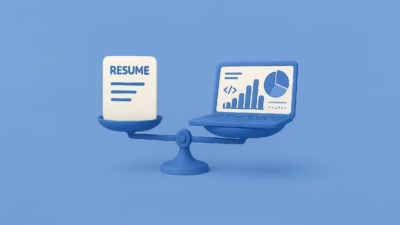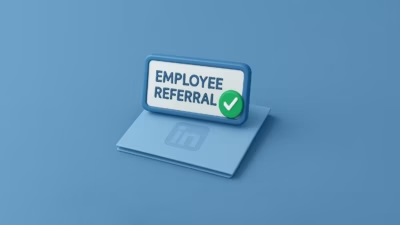Interviews can be nerve-wracking — and one of the trickiest moments often comes when the interviewer says:
“Tell me about a project you worked on.”
Suddenly, your mind races:
Which project should I pick? How much detail should I give? What if I forget something important?
Worse, many candidates start rambling, losing the interviewer’s attention and diluting the impact of their experience.
But don’t worry. With a little structure and practice, you can turn this moment into a powerful storytelling opportunity that shows you are job-ready, clear, and confident.
In this guide, we’ll break down exactly how to explain your projects in interviews without rambling, while capturing attention and leaving a strong impression.
Why Your Project Explanation Matters So Much
When interviewers ask about projects, they aren’t just looking for technical details.
They’re assessing:
- Problem-solving skills: How you approached challenges.
- Communication skills: Can you explain complex work clearly?
- Business sense: Do you understand the bigger picture?
- Technical depth: Did you really work on this, or just assist?
In short: Project explanations are a microcosm of how you’ll perform on the job.
Good storytelling = higher perceived competence.
Common Mistakes That Lead to Rambling
Before we talk about what to do right, let’s call out what usually goes wrong:
- No structure: Jumping between topics without a clear path.
- Overloading with technical jargon: Losing non-technical interviewers.
- Too much backstory: Spending five minutes setting the scene.
- Getting lost in side details: Talking about irrelevant hurdles.
- Over-answering: Trying to mention everything instead of what matters most.
If you’ve done any of these before — you’re not alone. The good news?
There’s a simple formula to fix it.
The 4-Step Formula: How to Structure Your Project Story
Use this clean, repeatable structure for every project you explain:
C.A.R.L. = Context → Action → Result → Learning
Here’s what each part means:
- Context (20% of your answer)
- What was the project about?
- What problem or goal were you addressing?
- Why was it important?
- Action (40% of your answer)
- What exactly did you do?
- Focus on your individual contributions.
- Mention key skills, tools, and decisions.
- Result (30% of your answer)
- What was the measurable outcome? (Impact > Effort)
- Use numbers if possible: time saved, errors reduced, revenue boosted, etc.
- Learning (10% of your answer)
- What did you learn technically and personally?
- Bonus points if you connect it to the new role you’re interviewing for.
Example:
“In my final semester, I worked on a predictive modeling project to forecast customer churn for a telecom company. (Context)
I led the data cleaning phase using Python (Pandas, NumPy), performed feature engineering, and built a logistic regression model with an 85% accuracy rate. I also created dashboards in Tableau for business teams. (Action)
The model helped reduce churn by 7% in a pilot region, which was projected to save $1.2M annually if scaled company-wide. (Result)
Through this, I learned the importance of balancing technical model performance with business interpretability, which I know is key in your customer analytics role. (Learning)”
This is clear, impactful, and under 2 minutes.
Tips to Nail Your Project Explanation
1. Pick the Right Project
Choose a project that:
- Matches the job description’s keywords (e.g., if the role wants SQL, highlight projects where you used SQL heavily).
- Showcases problem-solving, not just coding.
- You remember well enough to explain confidently.
Pro Tip: Prepare 2–3 projects in advance so you can tailor based on the interviewer’s interests.
2. Highlight Your Role, Not Just the Team’s
If it was a group project:
- Focus on what you personally owned.
- Use phrases like: “My responsibility was…”, “I led…”, “I specifically worked on…”
Hiring managers want to know what you did — not what the team did.
3. Stay Business-First, Then Tech-Second
Frame your project’s goal and business value first.
Wrong:
“I built a random forest model with 200 trees and hyperparameter tuning using GridSearchCV.”
Better:
“To help the marketing team predict high-value leads, I built a random forest model. I optimized it using hyperparameter tuning, which improved lead conversion prediction accuracy by 12%.”
Always link tech work to a business purpose.
4. Use Metrics Whenever Possible
Quantify success:
- Accuracy improvement (%)
- Time saved (hours/days)
- Revenue impact ($)
- Error reduction (%)
- Engagement increase (%)
If you don’t have hard numbers, approximate based on project goals.
Examples:
“Reduced manual data cleaning time by 40%”
“Improved customer segmentation precision by 15%”
“Helped streamline reporting, saving 8 hours/week for the analytics team”
5. Practice a 60–90 Second Version
Before the interview:
- Record yourself explaining a project.
- Time yourself — aim for 60 to 90 seconds per project.
- Cut any unnecessary details.
The goal:
Short, clear, and invite questions.
(You want them to ask for more if they’re curious!)
Bonus: What to Say If You Forget Something
Even if you prepare, nerves happen.
If you blank out during your project story:
- Pause.
- Smile.
- Say: “Let me back up and make sure I explain this clearly…”
- Briefly restate your key point.
Interviewers appreciate clarity over speed.
Taking a second to regroup looks professional, not bad.
Quick Checklist Before You Enter the Interview
- Have 2–3 projects ready
- Use C.A.R.L. structure (Context → Action → Result → Learning)
- Focus on your individual contribution
- Tie technical details to business outcomes
- Practice until you can explain each project in 90 seconds
- Quantify impact wherever possible
- Stay calm if you need to pause or reframe
Final Thoughts:
Good storytelling wins jobs.
When you explain your projects well, you’re not just talking about your past.
You’re showing you can communicate clearly, deliver real results, and think critically — exactly what employers want.
Master your project storytelling, and you’ll not only survive interviews — you’ll dominate them.





